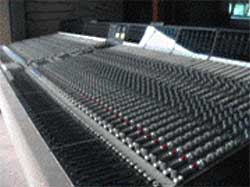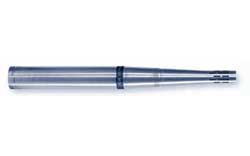|
|
|
The CD market today is severely depressed and there are several reasons why; most have been exhaustively discussed and understood.
However, the potentially most likely cause is self destruction by the industry. It’s a well know fact, and appreciated by most, that the sound quality of CDs is inferior to that of the old vinyl LP. That is a situation that cannot readily be corrected. There is one other even more important destructive force in the industry, which begins with the mixing console.
 This is an 80 channel mixing Console and is not necessary for classical CD production.
When one has the privilege of attending an Opera performance, live orchestral concert, chamber ensemble or solo instrument performance, one is accompanied by just one pair of ears. The auditorium was designed by an architect who understood the importance of the acoustic qualities of the ambiance and took into consideration the subsequent presence of an audience. The sound we hear there, in the concert hall, is the sound we would like to hear, or at least the nearest possible representation, emanating from our very expensive high fidelity system.
Having visited the local CD stockist we have rummaged very carefully amongst the 1000s of discs available, selected, without choosing a cheap copy, the work and artist of our choice. We carefully place the CD onto the tray and press the play button.
What do we hear? Probably a reissue, meaning yet more technical modifying. And yet even if it is the latest release there is a 90% chance it was recorded in a ‘dead’ studio. In the case of a symphony orchestra there were up to 32 pairs of microphones placed amongst the musicians. Each of the microphones was fed to a huge console where an engineer sat studying the score, as though he were the conductor. He faded in and out each instrument, group of instruments or the entire orchestra, according to its prominence at any particular point in the work. The resulting ‘mixed’ signal was then analyzed and corrected electronically and separated into two channels which finally were ‘burned’ onto the CD we had purchased.
Considering the technical process one might be surprised that the name of the conductor appears in the credits of the recording.
What has happened is that the entire process has got out of hand. The industry is offering CDs that are not faithful recordings of the composers work. They are technically constructed electronic sound monsters.
Appeal to the industry:
We, the customers, respectfully ask you to take a musical approach to the process of producing CDs
The process can be much more simple and probably with a lower production cost.
Record Producing companies who understand our grief and adhere to the following criteria will be permitted to add to each CD a logo in the following format:
Certified Natural Sound Technique Recording
What does it refer to and what does it imply?
Genre of music source
1. Opera
2. Full Symphony Orchestra
3. Chamber Ensemble
4. Solo instrument
Microphone Technique
Two very carefully positioned microphones capable of picking up all instruments of the orchestra over all frequencies with a flat response. Example Earthworks SR30.
 This is an Earthworks SR 30/HC used to record a full symphony orchestra with just two microphones.
Microphone Positioning
Positioning of the microphones is determined by the venue. However, the microphones should always be suspended - to avoid physically transmitted sounds and vibrations, also to take advantage of the effect of sound rising, (with heat).
Venue
If the venue is a concert hall then an audience should be present, since the acoustics of the hall, in general, was calculated to include an audience.
Should it not be possible to have an audience present or should the recording be undertaken in a studio situation then every endeavour should be made to simulate the natural ambient conditions of a concert hall with an audience. Public convenience echo is not appreciated.
Recording
Maximum record level should be established during the rehearsal or at the very least a short test undertaken. Following which no adjustments to level should be made during the course of the recording, the conductor being relied upon to take care of that particular factor.
Editing
If necessary removal of tape hiss. Excessive coughing and extraneous noises should be removed. No corrections should be made to the musical content.
Transfer
Direct transfer of the recorded material to the CD
Related resources:
The contents, views and opinions in this article are those of its author.
|
|
|
|
|
|